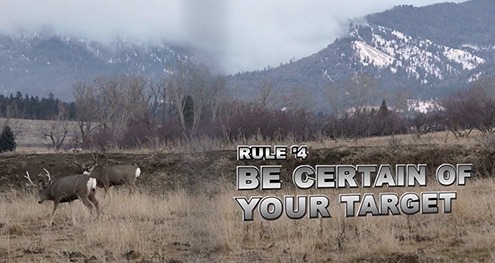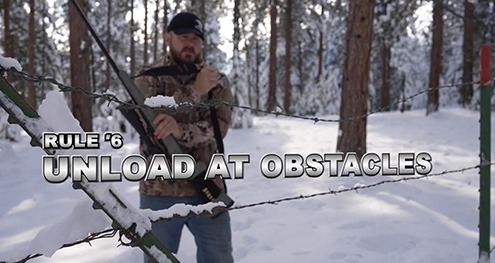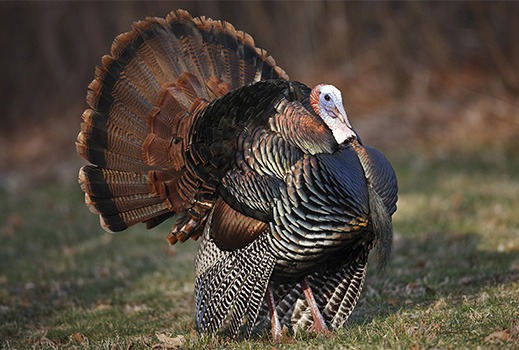
10 Tips to Keep Everyone (and the Dog) Safe in the Waterfowl Blind
When it comes to excitement, a good duck hunt ranks way up there. Starting with pre-dawn decoy placement, early morning flybys by ducks so close you can feel the wind off their wings and, if you’re lucky, breakfast in the duck blind, it all adds up to a great day afield for hunters of any age.
Etiquette in the Waterfowl Blind
Waterfowl hunting from a blind positioned on dry land involves fast-paced action in close proximity to other hunters, so its important not to let all that excitement lead to trouble. If you’re taking a young hunter on his or her first waterfowl hunt or taking anyone new to the sport along with you for the first time, go over these tips before you head out. Be sure, too, to stop as needed to point out these safety examples as your hunt unfolds, as seeing it live makes it easier to remember how to stay safe and keep your hunting companions safe on future hunts.
1. Leave the guns unloaded until it’s time to hunt, and unload when it’s over
There will be plenty of time for loading firearms after decoys are placed and everyone is settled into the blind and waiting for legal light. Once the hunt is over, make sure everyone has unloaded their guns before exiting the blind.

Make sure everyone in the blind knows where their safe shooting lanes are. Limit shots to directly in front of each blind position. No duck or goose is worth an accident.
2. Maintain your shooting lane
Explain safe shooting lanes like the hands on a clock, (even if you have to describe to young hunters what a clock is—LOL!). Each shooter gets a lane between 10 and 2 o’clock directly in front of them. This prevents each hunter’s muzzle from covering that of the other hunters in the blind. Birds on either end of the blind belong to the person on that end.
Maintaining your shooting lane is as much about being polite as it is about safety. Some hunters will always be better and faster than others, but when hunting in a group, everyone should get a chance to shoot. Taking shots at birds that haven’t gotten to your lane yet is considered bad form—very bad form. Do it and you may find yourself hunting solo from then on. Yes, there are times when birds will seem to favor one end of the blind, but duck and goose hunters who know the ropes will simply take turns in the hot spot.
Along those same lines, teach muzzle control and make certain everyone in the blind practices safe gun handling. When ducks are dropping into the decoys, it’s easy for a new hunter to get overwhelmed and lose awareness of where their gun might be pointing. Stop and help them out. Same for the times right after a shooting flurry. Drill gun safety into new hunters every chance you get and keep everyone in the blind safe.
3. Keep loaded guns in a secure position
Many hunters build gun racks along the front wall of their blinds to keep their loaded firearms (always with their safeties on) secure during the hunt while hunters wait in between passes of birds. That’s because a quick spin to check for birds coming in from behind or a reach for a cup of coffee can make it too easy to knock an unsecured firearm to the ground. If your blind doesn’t have built-in gun racks, make use of corners, stacks of gear or whatever else you can find to secure guns in an upright position.

Keep firearms secure in the blind, either in hand, in a rack, or propped solidly and supported by other gear to prevent them from getting knocked over by an excited hunter or dog.
4. Watch the dog
One of the best parts of waterfowl hunting is watching the dog work. While a well-trained dog shouldn’t break from the blind early, they sometimes get excited, too. Make sure all shooters are aware of where the dog is at all times, especially when one has been sent on a long retrieve and may be out of sight for a while. Establish a “no shoot” zone where no incoming birds can be shot at while the dog is outside the blind. No duck or goose is worth injuring your best four-legged hunting buddy.
Kids and dogs are a perfect fit, and they love to interact with one another when the action slows. Be careful to not let their exuberance (either the kids’ or the dogs’) knock over an unsecured firearm or a propane heater. And when the morning flight begins to fizzle and the action slows, realize that’s a great time to get both kids and dogs out of the blind to burn off a bit of energy. Find a handy stick to toss and teach the kids the basics of dog handling.

Dogs and kids are perfect together, but don’t let an excited dog create a dangerous situation in the blind. Make sure your hunters know that no shots are to be fired while the dog is out of the blind.
5. Keep those shotgun muzzles clear
Waterfowl hunting can be a muddy mess. Caution hunters to keep muzzles out of the dirt and explain to new hunters what can happen if you try to fire a shotgun with a plugged barrel. While on the subject, make sure all the hunters in your blind know to immediately stop shooting and unload any firearm if a shell fails to fire or sounded off or muffled at the shot. A barrel plugged with a shotgun wad from a squib load is just as dangerous as one plugged with mud.

Waterfowl hunting often takes place in wet, muddy conditions. Keep muzzles clear and free of mud that might plug them and cause a dangerous situation.
6. Don’t lend ammo without checking each shotgun
It’s important to make certain that only the correct gauge and shotshell size for the gun being shot is in each hunter’s possession. Even experienced hunters have made the mistake of loading a sub-gauge shell into a gun, then following it with the correct load. The smaller shells can travel up the barrel until they wedge, causing a dangerous blockage if the gun is fired. Too, if your buddy runs short on shells and you hand him one of your 3½-inch super-duper-magnum 12-gauge shells, you both better make sure his gun is chambered to take that longest of 12-gauges, otherwise he could have a very dangerous situation on his hands.
7. Wear eye and ear protection
Waterfowl hunting from a blind usually means a lot of close-quarters shooting. Ear protection in the blind can prevent irreversible damage to a hunter’s hearing. Electronic plugs that allow you to hear sounds in safe ranges but shut down sounds over 85 decibels work best, but even a set of foam plugs will help.
Shooting glasses protect against an errant pellet, an ejected hull from a neighboring gun and the errant sticks of foliage used to conceal your blind. As a bonus, amber- or yellow-tinted glasses can help with target acquisition in low light conditions.
8. Wear clothing that accommodates safe gun handling
You’re going to need to be able to shoulder your gun quickly and efficiently when the ducks are coming in sneaky and hard. A heavy overcoat or waders that cause you to catch the buttstock on the way to your shoulder, and winter clothing in layers that make reaching the trigger correctly a problem, can cause safety issues. So, too, can a gloved finger that can’t safely reach and activate the trigger. If you hunt waterfowl in weather hot to cold, you may need to consider having a second shotgun that fits you better over heavy parkas, waders and wading jackets (i.e., one with a shorter stock), and possibly one designed specifically for cold-weather hunts with oversized bolt releases, safeties and trigger guards that safely accommodate thicker gloves.
9. Never rely on your shotgun’s manual safety, but check it often
Periodic safety checks are habit in our waterfowl blinds after every round of shooting, and they apply to every hunter of any age. Safeties do not come off the gun until just before you pull the trigger on incoming birds, and they immediately go back on as soon as you’ve finished any round of shooting. They should be on when the guns are sitting in secured upright positions between flights of birds, and on if you have to pass your shotgun to another hunter.
10. Keep a fire extinguisher handy
You probably didn’t expect this one. It may seem odd, but waterfowl blinds are usually covered in very flammable materials like grass, cattails and dried brush. Couple that flammability with propane heaters and cook stoves common to cold-weather waterfowl hunting in blinds, not to mention your blind mates who enjoy cigars and cigarettes, and you can see why these structures have the potential to catch fire. A good fire extinguisher can prevent a small fire from becoming a big problem.

Propane heaters and cook stoves can ignite flammable blind material. Keep a fire extinguisher handy at all times.
-*-*-*-*-*
Kentucky native Michael Pendley has been hunting since he was old enough to say the word “rifle.” He’s been writing in the outdoor industry for the past 15 years, and his work has appeared in Field & Stream, Sporting Classics Daily, Modern Pioneer, Petersen’s Hunting and others, though he is perhaps best known for his “Timber 2 Table” column on Realtree.com. When he’s not in the kitchen whipping up something mouthwatering or sampling Kentucky’s fine bourbons, he, along with his wife and photographer, Cheryl, their daughter, Michaela, and their two sons, Hunter and Nathaniel (aka Potroast), along with their basset hound, Blanton, and bloodhound, Teddy, can be found traveling the country and enjoying everything the outdoors has to offer.







 Excise taxes fund wildlife research for the sustainable maintenance of healthy wildlife populations.[/caption]
The excise taxes established under the Pittman-Robertson Act have been a driving force, contributing over $16.4 billion (over $25 billion adjusted for inflation) to individual states. In this video, Peter Novotny, Deputy Chief of the Ohio Division of Wildlife, highlights how these funds, combined with hunting and fishing license dollars, fund essential wildlife research. This research enables a deeper understanding of how wildlife populations adapt to a changing environment, ultimately leading to the maintenance of healthy and sustainable populations.
Excise taxes fund wildlife research for the sustainable maintenance of healthy wildlife populations.[/caption]
The excise taxes established under the Pittman-Robertson Act have been a driving force, contributing over $16.4 billion (over $25 billion adjusted for inflation) to individual states. In this video, Peter Novotny, Deputy Chief of the Ohio Division of Wildlife, highlights how these funds, combined with hunting and fishing license dollars, fund essential wildlife research. This research enables a deeper understanding of how wildlife populations adapt to a changing environment, ultimately leading to the maintenance of healthy and sustainable populations.
 “We feel comfortable and confident that the excise tax dollars are helping keep healthy deer herds out there across the United States,” said Phil Bednar, President and CEO of TenPoint Crossbows.[/caption]
“We feel comfortable and confident that the excise tax dollars are helping keep healthy deer herds out there across the United States,” said Phil Bednar, President and CEO of TenPoint Crossbows.[/caption]
 Turkeys make a tough target. They are difficult to see and even harder to harvest. The head and neck are the only vital areas that ensure a fast, clean hunt, but this will only happen if your shotgun throws a tight, dense shot pattern.
The best shotgun choice for turkeys is a 12-gauge magnum, though the 10 gauge is gaining some ground among turkey hunters. The best shot sizes are No. 2, 4, 5, or 6. The best shotgun chokes are Full, Extra Full, and Super Full.
Turkeys make a tough target. They are difficult to see and even harder to harvest. The head and neck are the only vital areas that ensure a fast, clean hunt, but this will only happen if your shotgun throws a tight, dense shot pattern.
The best shotgun choice for turkeys is a 12-gauge magnum, though the 10 gauge is gaining some ground among turkey hunters. The best shot sizes are No. 2, 4, 5, or 6. The best shotgun chokes are Full, Extra Full, and Super Full.
